This post may contain affiliate links. If you make a purchase through a link, I may receive a small commission, at no cost to you. These commissions help keep this website up and running, and I thank you for your support. Read my full disclosure here.
Disclaimer: This is not a sponsored post, I paid for this trip myself. All recommendations are my own.
Warning: This post contains a ridiculous amount of photos because Morocco provides so many amazing photo opportunities! I’m no professional photographer and I only use a small basic camera, but it seemed like every photo I took looked beautiful, so I really wanted to share them with you.
Desperate for some respite from the grey, cold, overcast days of a UK winter, my husband and I searched the internet for some cheap flights to any destination that was offering sunshine. We come across some exceptionally cheap flights to Marrakech. Morocco gets insanely hot in the summer which can limit your activities, so visiting in February when the days are still sunny but comfortably warm, seemed like the perfect plan.
Day 1 – 3: Marrakech
Because we were flying on a budget airline, we had to depart at an insanely early time in the morning. However, that meant we arrived in Marrakech in the morning with a full day of sightseeing ahead of us.
When we arrived in the airport at Marrakech, we found a modern building with reasonably short lines to get through passport check. However, the line was quite slow as the staff spend a significant amount of time carefully checking each person’s details, so make sure that you have completed your customs form and have the details of your hotel available.
Once we were through customs, we stopped off at one of the money exchanges to change some cash to the Moroccan Dirham. It’s a closed currency, so you can’t obtain it before arriving, but it’s relatively straight forward getting your money exchanged at the counters. Our bags were then x-rayed as we left the airport.
We then followed the signs towards the airport bus which departs every 30 minutes. However, as we walked towards the bus stop, hoards of taxi drivers descended upon us offering ‘cheap’ trips. In reality, the airport really isn’t very far from the tourist Medina area, so the bus doesn’t take much longer than a taxi ride. Also, the bus drivers are very helpful and will assist you to figure out which stop you need and making sure that you get off at the right stop. Tickets were very cheap, and buying a return ticket was cheaper still. However, if you prefer you can pre-book an airport transfer.
Most tourists stay in the Medina. It can be difficult to find your riad in the confusing maze of this place, but usually the hosts will provide you a number in which to contact them and they can then come and meet you and show you the way. We managed to find ours OK though. However, be aware that there are a lot of young men and boys that will attempt to offer to show you to your riad and then expect you to pay them a significant amount of money for having done so. So don’t fall prey to this as apparently, they can become aggressive in an attempt to bully more money out of you.
In Moroccan culture, they don’t believe in displaying their wealth out of respect to those who have less. Therefore, the buildings look very plain and some a tad ugly from the outside. However, behind the door you will typically find a beautiful internal courtyard with colourful decor and soft furnishings. The design also means that it is very quiet inside compared to the hustle and bustle of the outside. Our riad had a rooftop terrace which provided a lovely place to relax whilst catching some rays. Despite it being winter, it was lovely and sunny.
Moroccan people are incredibly welcoming hosts. Once we arrived at our riad we were ushered into a communal sitting area and offered delicious sweet mint tea and some nibbles, and this same custom was repeated everywhere we stayed.
After checking in, we headed out to explore the city and found ourselves at Musée de Marrakech, not far from where we were staying. For a small fee, we viewed a collection of Moroccan art forms exhibited in the beautiful Mnebhi Palace. It’s internal courtyard features cedar archways, stained-glass windows, intricate painted door panels and mesmerising zellij tile work.
From there, we headed onto Koutoubia Mosque, with its 77 metre high minaret. This place is a highlight of Marrakech and was built between 1184 to 1199. It is surrounded by a large plaza and garden. The nearby Cyber Park is also worth a visit. It features ornamental gardens dating back to the 18th century and is a great place to escape the frenetic pace of the city and access some free WIFI. At the park entrance, we visited the small museum which had an interesting historical telecommunications exhibit.
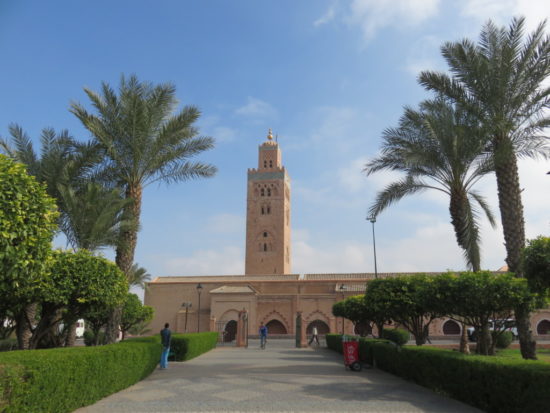
In need of some refreshments, we next visited the famous hustle and bustle of Jemaa el-Fna, Marrakech’s main square. Here we found a variety of stalls, the owners of which determined to convince us to purchase their wares. You can get freshly squeezed fruit juice, colourful pottery, fabrics and all sorts of Knick knacks at these markets. But try to steer clear of the snake charmers who have removed the fangs from their snakes, and the monkey handlers. Tourists are the reason this cruel trade continues. You also need to keep an eye on your bag and be wary of the women with the henna tattoos that will attempt to tattoo you without your consent and then expect money to fix it, with poor results. If you want to get a henna tattoo whilst you are in Marrakech, then keep reading and I will tell you how.
We were pretty tired by now and headed back to our riad to catch the final sunrays of the day on the rooftop terrace before heading out for a lovely dinner at LATITUDE31 (186, Rue El Gza Arset Ihiri, Bab Doukkala, Marrakech 40000). The restaurant served gorgeous modern Moroccan food. I had an amazing chocolate sphere for dessert which the waiter poured hot chocolate over it causing it to melt and reveal delicious fruit innards.
One of my favourite cultural experiences in Morocco was hearing the call to prayer. Five times each day large speakers throughout the cities and towns call out the prayer. However, if you are a light sleeper like myself, be prepared to be woken very early in the morning with the sunrise prayer. My husband seemed to have no problems sleeping through it though.
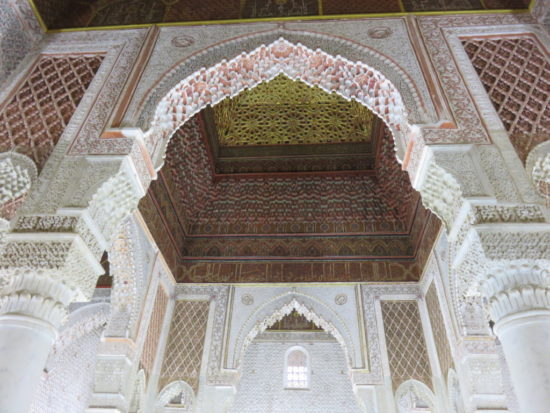
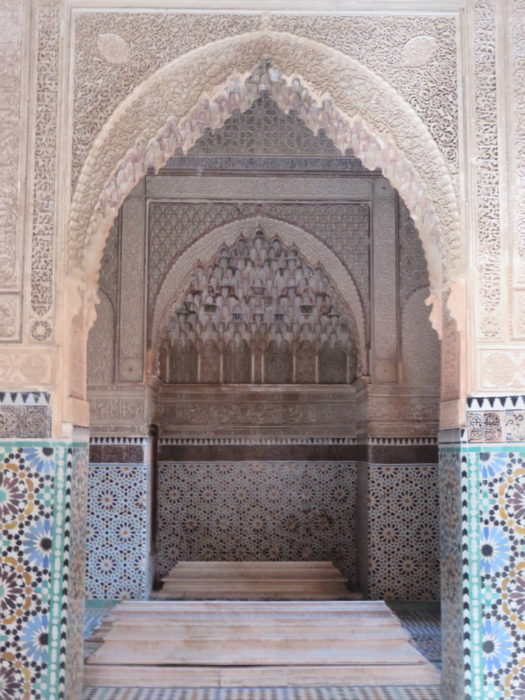
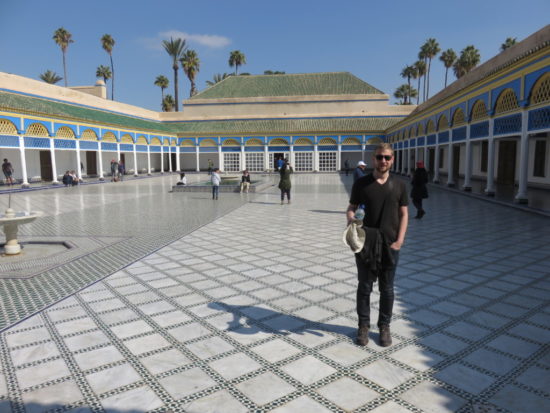

The following day we headed out to do some more sightseeing. The entry fees are incredibly cheap in Morocco, so make the most of it and try and get to these amazing sites. We started at the Saadian Tombs, a once hidden mausoleum surrounded by gardens. They date from 578-1603 and were discovered in 1917. The tombs have been restored and are beautifully decorated with colourful tiles, marble and stucco. It is not very large, so doesn’t take long to visit, but I think this amazing piece of history is worth seeing.
Nearby are two palaces El Badi and Bahia. We first headed to the closer El Badi Palace. This is the remains of a 16th-century palace and is quite large, so we spent several hours exploring this place. Be warned, it is hot (and we were visiting in winter, so I can only imagine how hot it would be in summer) and as only ruins remain, there is very little shelter overhead, so take a large bottle of water with you and wear a sunhat. I found this place fascinating, especially the historical photo exhibition in the basement area and the huge storks that nest here, sadly incorporating plastic bags into their nests.
After a much needed tagine refreshment break, we moved onto Bahia Palace. Built in the late 19th century, the grounds are vast, with 160 rooms, courtyards and 8 acres of gardens. The palace is beautifully and intricately designed. The harem includes a vast court decorated with a central basin and surrounded by rooms intended for the concubines. Unfortunately, it is not furnished as it was plundered by the descendants for their own palaces. I would love to have seen this place in its heyday.
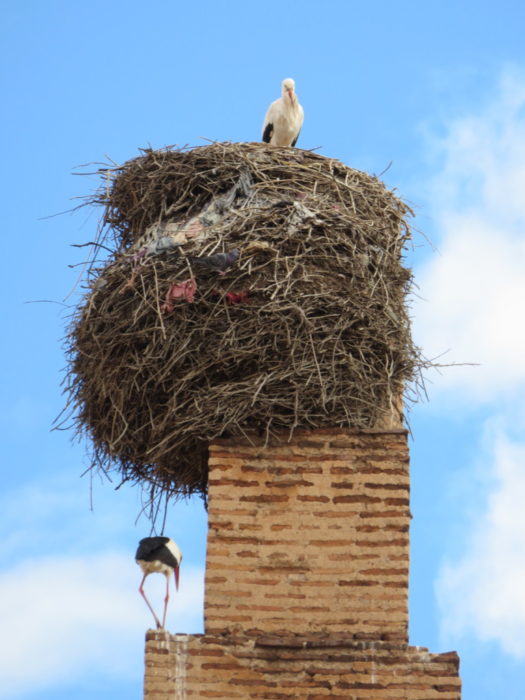

In the afternoon, we headed to the Henna Café (93 Arset Aouzal, Marrakech) for a henna tattoo. Downstairs they run a henna school and upstairs on the covered terrace is the café. They also serve some good, simple, vegetarian food and even have tortoises wandering around! As well as the food menu, you will find a henna tattoo menu with a range of designs to choose from and set prices (no negotiating). The prices are reasonable and fair, especially as they are very good quality and carried out by trained local women. Make sure you put some time aside for this as you will need to sit and wait at least 15 minutes to allow for the paste to dry. They will also applied a lemon sugar glaze over the tattoo to help it set. You can leave after this, but it takes about an hour to fully dry, so you need to be careful not to smudge it during this time. You are advised to leave the henna on at least 8 hours to get a good strong colour and long lasting stain. The café supplied me with a free cotton bag to use as a cover to protect my tattoo and clothes from getting stained. The next day I carefully removed the dried henna and it looked great and lasted for weeks.
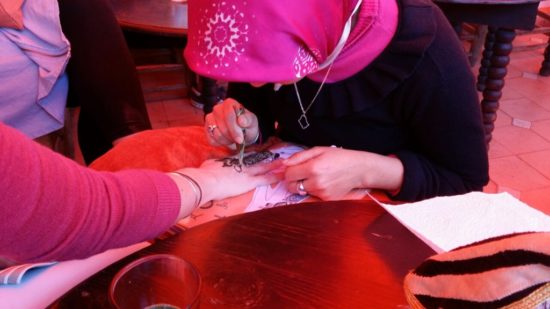
Accommodation Options in Marrakech
Search available accommodation in Marrakech
Budget
Moderate
Luxury
- Es Saadi Marrakech Resort – Palace
- Dar Rhizlane, Palais Table d’hôtes & SPA
- La Maison Arabe Hotel, Spa & Cooking Workshops
- Royal Mansour Marrakech – I just had to include this one because it’s super luxurious!
Day 3: Marrakech – Tizi N’tichka Pass – Aït Benhaddou – Ouarzazate – Skoura – Dades Valley
I paid for this tour myself. I have not been asked or paid to promote this tour service.
The following day we headed out before breakfast to commence our road trip. As we were leaving super early, our riad kindly provided us a packed breakfast and even escorted us to our tour meeting point. We joined another couple on a small group tour with Marrakech Day Trips. We would have usually preferred to have hired a car and driven ourselves, but we wanted to travel a long way in a short time, so decided to take a small group tour instead.
Many people attempt to visit the Atlas Mountains and Sahara in 3 days, but this means your trip will be rushed and consist of sitting in the vehicle the entire time. I would strongly recommend you take at least 4 days to do this trip. If you are lucky enough to have time on your side, then do it! You won’t regret it. It’s an amazing trip. I also definitely recommend Marrakech Day Trips as our driver/tour guide was excellent and made sure we got the most out of our trip.
Along with our driver and another couple from Belgium, we headed towards the magnificent Atlas Mountains. The roads were much better than I thought they would be, in fact everywhere we went, massive road works were being carried out order to improve the quality of the roads.
There were lots of viewing areas in which to pull over which gave us the opportunity to take in the views from all angles. Tizi N’tichka Pass at 2260m in altitude was a particularly picturesque place to stop, providing us with stunning views and amazing photo opportunities.
If you are keen to buy some cosmetic argan oil, then visit one of the Fair-trade cooperatives on your way through the mountains. These businesses enable local women to earn an income and provides them financial independence, which is difficult for women in this part of the world. Prices are usually fixed, but fair. The argan tree is only found in this part of the world. You’ll frequently see them quite literally filled with goats, who love to feast on them. They produce argan nuts. The flesh of the fruit is removed and inside is a hard nut, which they crack open to expose the kernel. Raw oil is used in cosmetics and is good for the hair and skin. However, when roasted, the kernel oil is used for cooking purposes and the nut is made into a really delicious peanut butter. These shops also sell yummy argan honey.
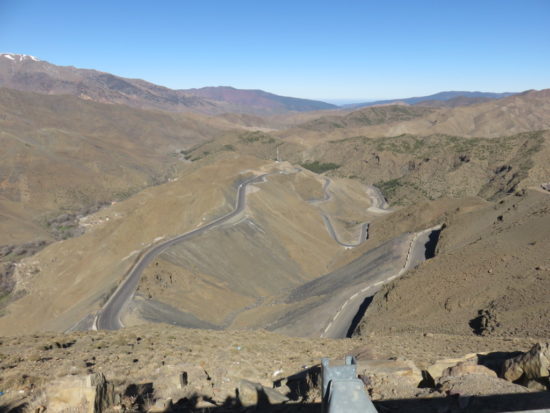
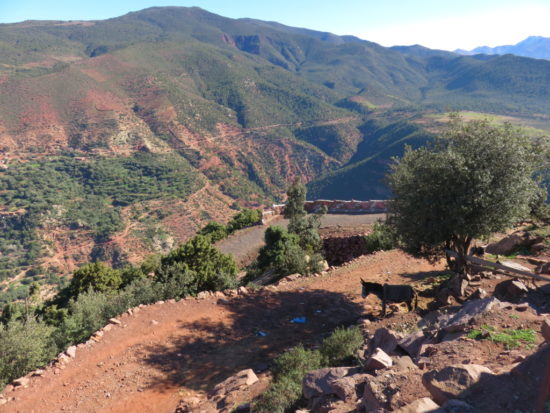
About midday, we arrived at the ancient walled city of Aït Benhaddou, a UNESCO world heritage site. This Kasbah located on the former caravan route between the Sahara and Marrakech, and is one of the most visited sites on day trips out of Marrakech. Many films have been shot here such as Gladiator, Game of Thrones, Star Wars and Lawrence of Arabia. It’s a fascinating place to walk around and if you can manage to walk up to the highest point, it offers magnificent views of the surrounding area.
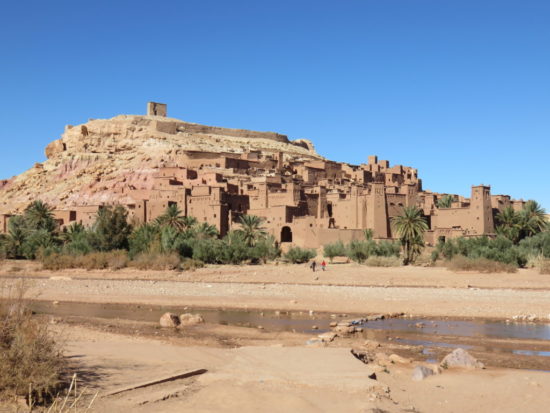
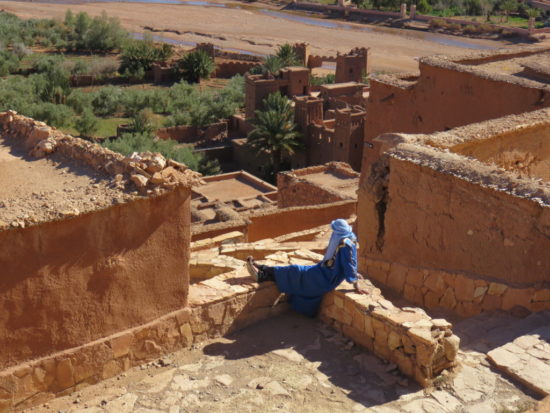
Following lunch, we continued on the long drive through Ouarzazate and Skoura to the M’Goun Valley, otherwise known as Roses Valley. It’s famous for its scented roses which bloom from April to mid-May. How these roses first got here is a bit of a mystery, but they grow wild all over this area. The variety is the Rosa Damascena, the Damask rose, which originates from ancient Syria and has an intense perfume. The local women gather the petals by hand and they are made into rose water, soaps and pot-pourri, but most is exported to France to be used in perfumes. Unfortunately, we weren’t there for the rose season, but there were lots of local shops dotted along the road selling their rose products.
In the evening we arrived at Dades Valley. Referred to as the “Route of one thousand Kasbahs“, the valley is scattered with palms and Kasbahs. The valley is absolutely beautiful and in the evening, the sunset transformed the clay into a deep, bright orange. That night we got the opportunity to stay in an impressive Kasbah hotel called Hotel Babylon, which I would thoroughly recommend (but I’ve listed some alternatives below). The staff were very attentive and friendly and the food was delicious. They also put on some lively evening entertainment.
Accommodation Options in Dades Gorge
Search available accommodation in Dades Gorge
Budget
Moderate
Luxury
Day 4: Dades Gorge – Todgha Gorge – Touroug Town – Erfoud – Erg Chebbi (Merzouga)
The following day, we started out early and spent some time exploring the Dades Gorge before heading on through Tinghir, with its date palm plantations and canyon views. Nearby is the magnificent Todgha Gorge. We were able to stop here a while and go walking along the spectacular gorge. We watched as the Berber people walked their animals down to drink and to fill their water containers.
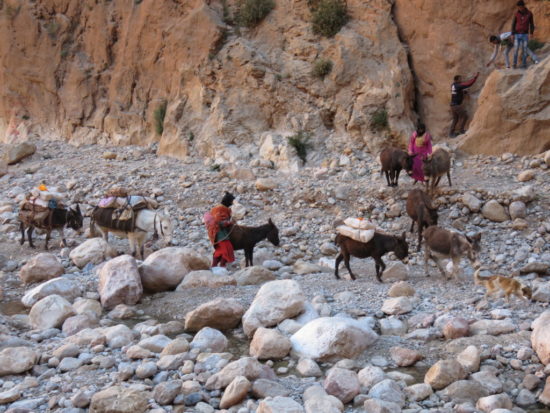
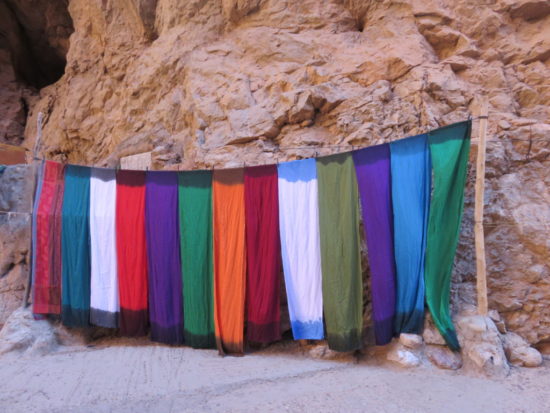
In the afternoon, we headed out to the Sahara for our camel ride. We arrived at the captivating dunes of Erg Chebbi, also called Merzouga Dunes. We packed a small bag for our overnight stay and after a mint tea break at the hotel, we loaded up our camels to head out into the desert for the night. We were accommodated by Ksar Merzouga Hotel & Camps who were excellent, but I’ve included a range of other desert camping options below as well.
Despite making a lot of gurgling and groaning sounds, our camels were very well behaved. I was impressed with how calm and gentle the handler was with them. Once we arrived at the camp we were served some more mint tea and shown our tents for the night. The sun was heading down, so we headed up to the top of the large sand dune by our campsite to enjoy the evening views. It was so peaceful. Despite being hot during the day, the Sahara gets very cold at night in the winter, so you need to pack warm clothes.
The Berbers running this camp site were extremely hospitable. The dinner was laid out for us in a large communal tent. I was impressed with how splendid and delicious it was, as I was expecting something more basic. We were travelling with a vegetarian, who thought she would struggle with the food arrangements, but this was no problem for the cook, who whipped up a gorgeous vegetarian omelette that apparently tasted delicious. In the evening, the staff put on a large bonfire for us to enjoy and spent time telling us about their culture and teaching us Berber words.
I won’t lie, the tents were very basic consisting of just a bed, which they cover with lots of blankets (trust me, you’ll need them in the winter), and there was a communal toilet. However, if like us you go camping, then this shouldn’t faze you and the campsite was very tidy and well maintained. If you visit during the summer months, you have the option of sleeping outside under the stars, but in the winter months, it’s just too cold.

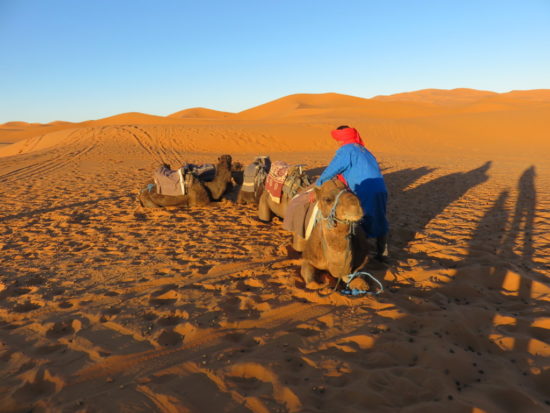
Desert Camping Options in Merzouga
Search available accommodation in Merzouga
Budget
Moderate
Luxury
Day 5: Merzouga – Alnif – Tazzarine – Agdez – Ouarzazate
Following a very chilly nights sleep where we had buried ourselves deep in blankets, the early morning call to prayer from the speakers nearby woke us and we jumped out of bed and staggered up the dune to watch the sun rise. After some mint tea, we gathered our belongings and headed back on our camels to the hotel base camp where we enjoyed a rather splendid breakfast which included some delicious native dishes and local honey. Then we washed the desert dust off ourselves in the showers made available to us.
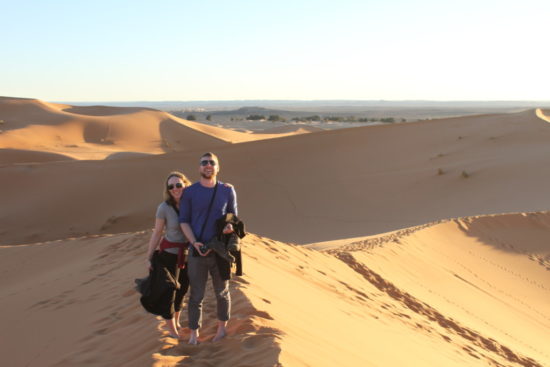
Our driver then drove us to a local town and took us on a tour of its local market where he helped us to identify each of the spices and foods available and helped us to get a good deal on a large box of delicious medjool dates, at a fraction of the cost at our local supermarket. We also stopped off at a fossil workshop. This part of Morocco is absolutely packed with the most fascinating fossils, so attract many international fossil hunting tourists. The staff showed us the different types of fossils and explained the process for removing them and then turning them into a range of items from bathroom basins, to chess pieces.
Although the dramatic scenery was amazing, it was sad to see the countryside absolutely littered in plastic bags, blown across the landscape from the cities and town. It will make you think twice before using a plastic shopping bag and support the ban of them.
We passed through Alnif, Tazzarine and the Draa valley, crossing the magnificent rocky mountains, Ait Saoun. We stayed the night just out of Ouarzazate.
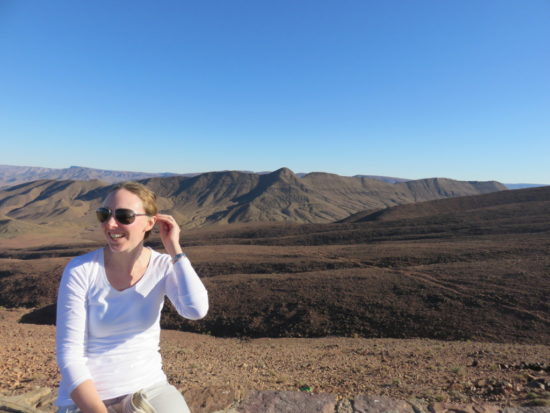
Accommodation Options in Ouarzazate
Search available accommodation in Ouarzazate
Budget
Moderate
Luxury
Day 6: Ouarzazate – Ounila Valley – Telouet – Marrakech
It was another gorgeous sunny day as we headed back towards Ouarzazate. We visited a local textile store where woman created beautiful materials and embroidery. The colours were gorgeous, I would have loved to have been able to buy more, but with limited luggage space, we opted for a pouf in sunset colours.
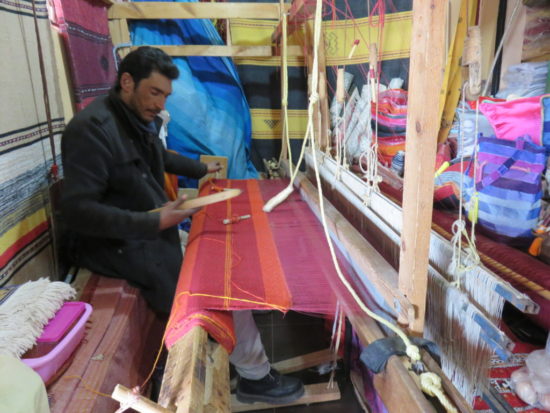

Ouarzazate is famous for its film studios Musee du Cinema and is the site of many famous films such as Kingdom of Heaven, Gladiator, Lawrence of Arabia, The Mummy Returns and Game of Thrones (Season 3). If you don’t have time to visit, then you can view the studios from the hill above it.
We passed through the spectacular Ounila valley to get to Telouet, an old Kasbah along the former route of the caravans from the Sahara over the Atlas Mountains to Marrakech. It was the seat of the El Glaoui family’s power, but now it is steadily becoming more damaged and is slowly collapsing. More recently there has been some work to save this building, and for a small fee you can visit and see some of the restored rooms. There is also an amazing view of the surrounding area from the rooftop. The valley is beautiful, full of palms and the almond trees were beginning to blossom.
We passed back over the High Atlas Mountains and on the way stopped to enjoy lunch in a restaurant that provided amazing views of the mountainside. In the afternoon, we arrived back in Marrakech. Tired from our adventures, we spent the afternoon relaxing on the sunny terrace of our riad.

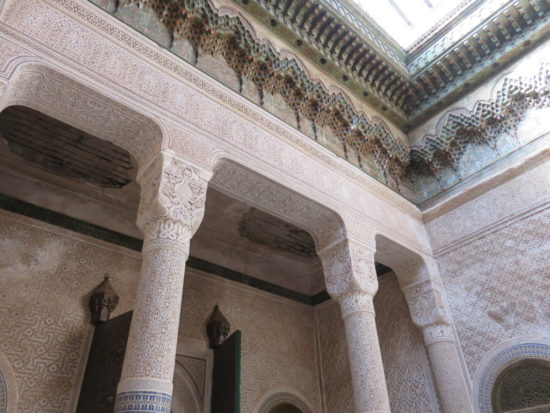
Day 7: Marrakech
The following day, we decided some pampering was in order. We headed to a hammam for a treatment. We went to Les Bains d` Azahara (I have not been asked or paid to promote this service) which was near our riad and chose to get a couple’s treatment. We were shown into a small room with a shower and lockers and given robes and disposable g-strings to change into, which my husband was rather concerned about ‘falling’ out of. We were then shown into a very warm tiled room with two heated stone benches to lie out on.
Now this is where you need to leave your fear of being naked at the door, because a proper hammam requires you to get naked and be vigorously scrubbed down by a stranger! After being exfoliated with traditional black eucalyptus soap, and a Ghassoul clay mask we relaxed on the hot benches for a while. We were then led into a seated area to have our rose petal foot soak, followed by a foot massage, whilst drinking a relaxing mint tea. Finally, we were shown into a private room for our massage.
Suitably relaxed, we decided to do some sightseeing and headed to Jardin Majorelle, a garden which has been open to the public since 1947. However, it has become more famously known as Yves Saint-Laurent’s garden since him and Pierre Bergé purchased it in 1980. After he died in 2008 his ashes were scattered in the garden. This place gets very popular so can get a bit crowded, but if you are into cacti and succulents, then this is your dream garden. There is also a Berber museum onsite, and a soon to be opened museum dedicated to Yves Saint-Laurent.
In the afternoon we wandered around the souks which are a labyrinth. Now I would normally say that my husband and I are both reasonably good with directions and finding our way around. However, we did end up quite literally walking in a circle without meaning to!
In the evening we had a lovely dinner at Le Comptoir du Pacha (218 Arset Aouzal, Bab Doukkala – Medina, Marrakech 40030), a lovely French Moroccan restaurant. The wine and food was excellent, and with a guitar player to serenade us, it created a very romantic holiday atmosphere.
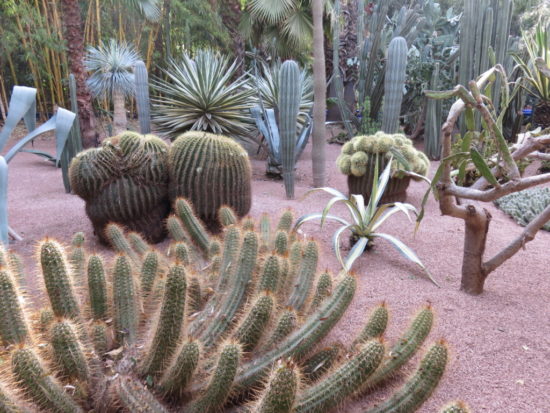
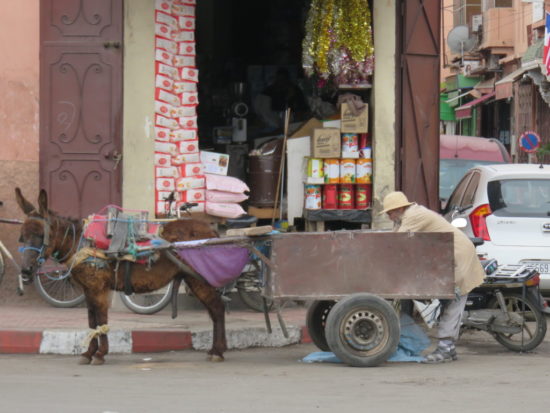
Day 8: Day Trip to Essaouira
The next morning, we got up early and headed to the bus station, located in the Gueliz district just behind the train station. The buses to Essaouria are run by Supratours. If you are travelling in the busy season, then you will need to book this in advance, but in the quieter winter months, its usually fine. It takes about 2 hours to get to Essaouria, but the buses are reasonably comfortable.
Essaouria is a popular tourist coastal town. When we arrived, we headed down to the lively port, filled with fishing boats and nearby fish markets. We also explored the old fortress in the harbour. We then meandered around the 18th century Medina which is listed as a Unesco’s World Heritage site. It is a wonderful place for a stroll and to get lost in. It has a much more laid back feeling to it than the Medina in Marrakech, and I found the items being sold to be better quality and cheaper. There are also lots of trendy modern Moroccan café’s, restaurants and hotels as well, but they seem to blend in well with the old.
Before heading home, we enjoyed a stroll along the beach and the esplanade. Although beautiful, this beach is not as popular with tourists looking for a beach stay because it is notoriously windy for most of the year.

If you have more time that we did and decide to stay in Essaouria, here are some accommodation options:
Accommodation Options in Essaouira
Search available accommodation in Essaouira
Budget
Moderate
Luxury
- Heure Bleue Palais – Relais & Châteaux
- Le Medina Essaouira Hotel Thalassa sea & spa, MGallery collection
- Wellness-Week – if you are looking for a retreat where you can focus on your health and well-being, then this is it!
Day 9: Fly Home
Sadly, our holiday had come to an end. We had our final meal at the trendy rooftop restaurant La Terrasse des Epices (15 Souk Charifia Sidi Abdellaziz Dar el Bacha, Marrakech 40000), a French Moroccan restaurant which also serves alcohol, delicious food, gorgeous desserts and rooftop views of Marrakech. I also had a yummy pastilla here.
Whilst waiting at the stop for the airport bus we were approached by a number of taxi drivers offering to provide us a cheap taxi trip instead of the bus. Surprisingly, once we told them we had return bus tickets, instead of walking away and finding another tourist to hassle, they chatted to us and offered advice about when the next bus should be arriving. Then when the bus was arriving, they made a real point of telling us to ensure we didn’t miss it and fare welling us. I guess I was surprised by their genuine offer of hospitality, as this wasn’t the response you would necessarily expect in this situation. But I’m sharing this with you because, despite the run-ins that some tourists have with the less agreeable individuals, at the heart of it, the people of Morocco are generous, welcoming and warm people. And despite some of the crazy things that are happening in other countries around Morocco, I have a deep respect for the way they manage to keep and even keel. We can’t wait to visit again in the future.
Practical Tips for Your Trip to Morocco
- Atlas Mountains and Sahara tour: If you are wanting to take the same tour into the Atlas Mountains and Sahara as we did, then I recommend booking with Marrakech Day Trips.
- Language: The people of Morocco are amazingly talented multi-lingual speakers. Whilst there we spoke a mix of English and French, but we tried to speak some Moroccan as well. When we were staying with the Berber people they were very keen to teach us Berber as well, so do make the effort to try a few words, they really seemed to appreciate the effort.
- Yes = N’aam
- No = La
- Please = Afak (Moroccan) or Lah ihefdak (Lay hefdak translates as may god protect you).
- Thank you = Merci (Mare-see – French)
- Hello = Bok (bohk)
- Currency: The Moroccan Dirham is a closed currency, so by law you are not allowed to import or export Moroccan Dirhams and you are not allowed to take more than 1000 Dirhams into or out of the country. Arrange to exchange your cash upon arrival and departure. There are ATM machines available throughout Marrakech. Except for large hotels and restaurants, most places in Morocco accept only cash, so make sure you have enough on you.
- Tipping: Not required, but people usually round up. Upmarket restaurants may add 10% to your bill.
- Electricity: The electrical current is 220 volts AC. Wall outlets generally take the European two round prong plugs. However, you are better off purchasing a worldwide adaptor with USB ports that can be used in Croatia as well other countries. At least then you can potentially get some further use out of it on future vacations. If you’re taking a number of electronics with you, then I would recommend purchasing a couple of these adaptors.
- Navigating: Google offline maps won’t work here, but even with internet access, Google is not so great at finding its way around the Medina’s. We ended up going old school and using the map from our Lonely Planet Pocket Marrakech Guide to get around Marrakech. Its small size made it easy to tuck into my bag. We didn’t need one for getting around Essaouria as it is quite small. However, if you are planning a self drive holiday, then you will need to get good road map of Morocco.
- What to wear: When it comes to dress, be sensitive and respect their culture. I predominately wore long sleeve cotton tops and ¾ pants with some comfy walking shoes.
- Mosques: There are no active mosques in Morocco that non-Muslims are allowed to enter.
- Camel trekking: You can’t take your suitcase with you, so take a small bag with you (e.g. a back pack) to pack your personal items into for an overnight stay. They sling your bag over the pommel of the camel saddle.
- Budget: Morocco is a cheap place to visit. Food, accommodation, transport and entry fees for sites are cheap.
- Alcohol: Although a predominantly Muslim country, Morocco is not dry. Alcohol is available in some restaurants, bars and hotels, however, not readily available in smaller country areas. There are some very good local beers and wine. Out of respect, don’t stagger around the streets drunk.
- Sexism: Be prepared for casual sexism. They don’t mean offence by it, that’s just how they view life. The woman is in charge of the home and the man is in charge of providing for the family. Each respect the others role.
- Couples: Unmarried Moroccan couples cannot legally share a hotel room. However, providing both of you are non-Moroccan (as evidenced by your passport), unmarried couples are allowed to share hotel rooms. You shouldn’t have any issues, but just don’t make a point of bringing it up, best left unspoken. Also, show some constraint when it comes to PDA.
- What to pack: If you are visiting in the summer, then be prepared for some potentially very hot days, especially as you head in land. However, take warm clothes too, as it gets really cold at night, especially in the Sahara.


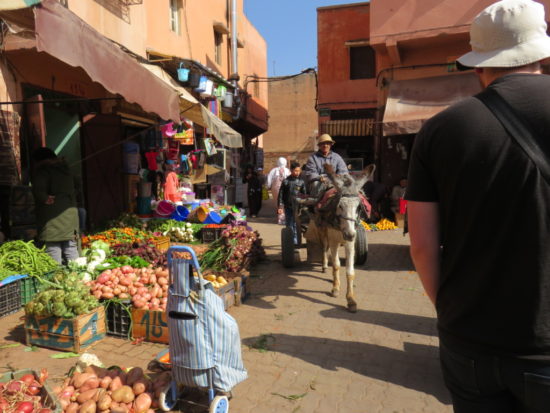
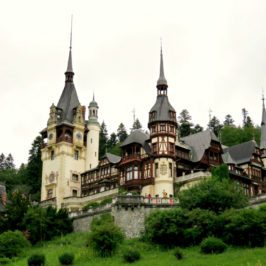

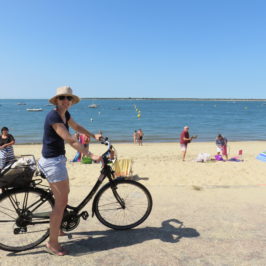
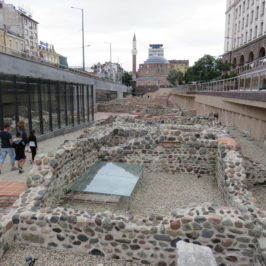

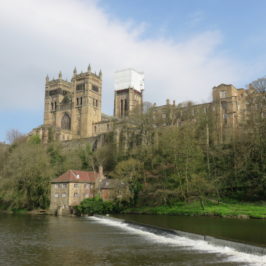
Leave a Reply